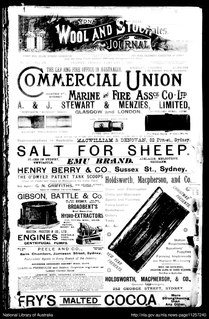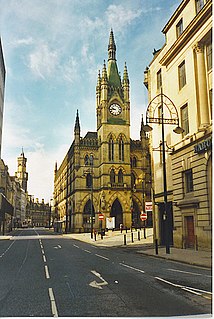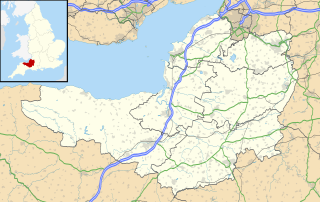 W
WThe Amendments to the National Wool Act Pub. L. 103-130, 107 Stat. 1368-1369 (1993), signed into law November 1, 1993, phased out wool and mohair price supports at the end of 1995.
 W
WA wool bale is a standard sized and weighted pack of classed wool compressed by the mechanical means of a wool press. This is the regulation required method of packaging for wool, to keep it uncontaminated and readily identifiable. A "bale of wool" is also the standard trading unit for wool on the wholesale national and international markets.
 W
WCimba was a British-built clipper in the Australian wool trade. She sailed between London and Sydney for 20 years, from 1878 to 1898. In 1905, Cimba set the sailing ship record for a passage from Callao to Iquique, of 14 days.
 W
WCromdale was the last clipper ship built for the Australian wool trade.
 W
WLavenham Wool Hall, also known as the Swan Hotel, is a timber framed building on Lady Street in Lavenham, Suffolk, England. Dating from the fifteenth or sixteenth centuries, it has been protected since 1958 as a listed building.
 W
WLoch Vennachar was a three-masted iron sailing ship (clipper) that operated between Great Britain and Australia between the late 19th century and 1905. The name was drawn from Loch Venachar, a lake which lies to the south-west of the burgh of Callander, in the Stirling region of Scotland. It is understood to mean "most beautiful lady" in Scottish Gaelic.
 W
WThe medieval English wool trade was one of the most important factors in the medieval English economy. 'No form of manufacturing had a greater impact upon the economy and society of medieval Britain than did those industries producing cloths from various kinds of wool'. The trade's liveliest period, 1250–1350, was 'an era when trade in wool had been the backbone and driving force in the English medieval economy'.
 W
WThe Mesta was a powerful association protecting livestock owners and their animals in the Crown of Castile that was incorporated in the 13th century and was dissolved in 1836. Although best known for its organisation of the annual migration of transhumant sheep, particularly those of the Merino breed, the flocks and herds of all species of livestock in Castile and their owners were under the oversight of the Mesta, including both the transhumant and the sedentary ones. The transhumant sheep were generally owned in Old Castile and León, where they had their summer pastures, and they migrated to and from winter pastures of Extremadura and Andalusia according to the season.
 W
WMississippi Mills was a cotton and wool textile manufacturing complex that operated in Wesson, Mississippi, during the latter half of the 19th century. By 1892, Mississippi Mills was described as the largest industry of its kind in the South.
 W
WThe National Wool Act of 1954 provided for a new and permanent price support program for wool and mohair to encourage increased domestic production through incentive payments.
 W
WThe Sydney Wool and Stock Journal was a weekly newspaper published in Sydney, New South Wales, Australia from 1890 until 1917. It was originally published as The Sydney Wool and Produce Journal.
 W
WThe Wool Act of 1699 was an Act of the Parliament of England, long titled An Act to prevent the Exportation of Wool out of the Kingdoms of Ireland and England into Forreigne parts and for the Incouragement of the Woollen Manufactures in the Kingdom of England. It was intended to increase England's woolen product manufacturing by preventing Irish wool production, manufactures, and export; it also forbade the export of wool and products from the American colonies. Competing woolens from these areas had recently become more available in foreign and domestic markets. The Act prohibited American colonists from exporting wool and wool products, or export to markets outside the individual colony in which it was produced, or to be transported from one place to another in the same colony. The act did not forbid the making of woolen fabrics for private consumption, but simply forbade the making of woolens for the public market. At this time the woolens exported from England had to pay heavy export duties. The act, one of the Acts of Trade and Navigation, was mainly aimed at Irish woolens and established a policy to crush the Irish woolen industry. It had little effect on the American colonies, at most it only slowed the potential industry. Shopkeepers had a very hard time during this period when the Wool Act was in force. Some colonists opposed this act by buying more flax and hemp.
 W
WThe Wool Exchange Building in Bradford, West Yorkshire, England is a grade I-listed building built as a wool-trading centre in the 19th century. The grandeur of its Gothic Revival architecture is symbolic of the wealth and importance that wool brought to Bradford. Today it is a Waterstones bookshop as well as a cafe.
 W
WThe Wool Hall was a residential recording studio in the village of Beckington, near Bath, Somerset, England.
 W
WThe Wool House is a medieval building in Southampton, Hampshire, England which was built to serve the wool trade. It has since had various uses.
 W
WA wool-stapler is a dealer in wool. The wool-stapler buys wool from the producer, sorts and grades it, and sells it on to manufacturers.
 W
WThe Worshipful Company of Woolmen is one of the Livery Companies in the City of London. It is known to have existed in 1180, making it one of the older Livery Companies of the City. It was officially incorporated in 1522. The Company's original members were concerned with the winding and selling of wool; presently, a connection is retained by the Company's support of the field of wool production and related fields. However, the Company is now primarily a charitable institution.